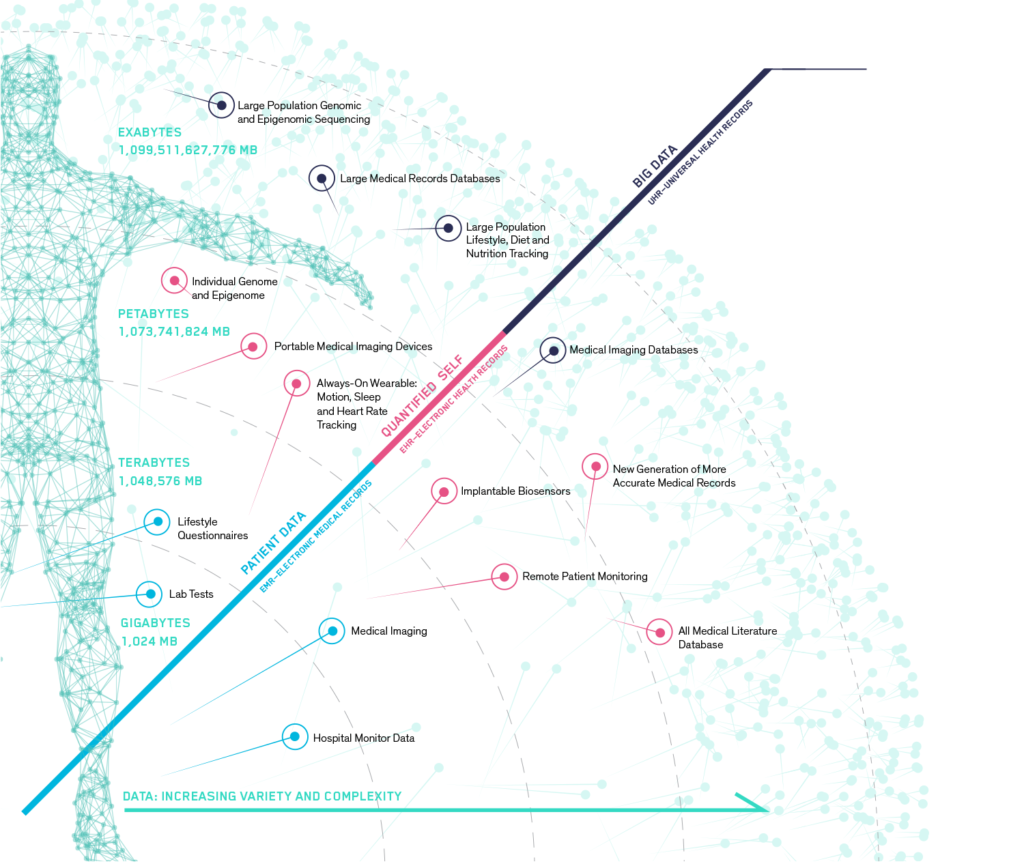Forecasting Disease with Data
Lots of diseases are preventable, but they happen so slowly that people get worse without realizing it. If we can use deep learning as a powerful tool to give patients a wake-up call, we’d be able to prevent diseases when there’s still time.
—Professor Narges Razavian
New York University Langone School of Medicine
Data: Increasing Variety and Complexity

THE SOURCES OF DATA PUT TO USE BY AI WILL BOTH WIDEN AND DEEPEN OVER THE NEXT DECADE
The amount of data created by the human body is potentially limitless, and the collection of that data has already moved outside hospitals and doctors’ offices.
Fitbits and watches that collect health information on sleep, activity and heart rate are just the beginning. Sophisticated mobile cardiac monitoring devices and implantable blood chemistry sensors will produce always-on patient data. Such devices will first be deployed on patients with serious illnesses, but eventually they will become so small, noninvasive and inexpensive that they will be used by everyone. Information will be instantly sent through our mobile devices to the cloud to be monitored on health dashboards at lifestyle-disease companies that send alerts to your doctor when diseases are forecast in your future.
As real-time data collection becomes widespread, new groups of previvors will emerge. Eventually, AI will be able to combine lifestyle and environmental data, genetic propensities and biometric tracking to forecast most major diseases sometimes years in advance.
These predictive diagnostics, real-time data and genomic analysis will combine to form a new data standard:
the Universal Health Record.
BY THE TIME PATIENTS BEGIN SHOWING UP AT DOCTORS’ OFFICES IN DRIVERLESS CARS (ANOTHER AI ADVANCE), MANY OF THEM WILL BE EXPECTING TREATMENTS FOR DISEASES THEY DON’T YET HAVE
This will likely lower healthcare costs, as fewer patients will present in acute condition, but will require a rethinking of treatment offerings. The promise of AI disease forecasting—particularly when it comes to diseases affected by lifestyle—is that the longer the patients have to change their behavior, the more chance they have of avoiding or deferring the illness.
As effective preventive interventions come online, more and more people will want to know their previvor status. Early detection will become an obsession. To avoid costly acute illnesses, wearing sensors and having blood labs done monthly won’t just be covered by your insurance provider—it’ll be mandatory.
Soon sensors—some just outside the body, some inside—won’t just monitor the body, they’ll actually intervene. Many people will be wearing some equivalent of an automatic insulin pump for their previvor condition. Already, over 100,000 Parkinson’s patients have pulse generators implanted in their chests that are wired up to their brains to control tremors. In this way, medicine will be mimicking the body’s own homeostatic systems, ever shortening the loop between
BLACK BOX DIAGNOSIS
The long-term outlook for AI and previvorship is a little spooky. As AI machines mine more data, patients will learn that they are headed for certain diseases without any clear understanding of how the AI algorithm made that determination. This opacity is what technologists refer to as the “dark secret” of AI: the way it looks for patterns in data becomes so complicated that not even the computer scientists who design the algorithms can reverse engineer the patterns it ultimately recognizes.
With life-and-death stakes, accuracy will outweigh our desire for human comprehension. A computer may one day tell us to expect a heart attack within the next year but not be able to tell us exactly how or why that prediction was made. “We can build these models,” one researcher said, “but we don’t know how they work.”
Whether it’s an investment decision, a medical decision or maybe a military decision, you don’t want to just rely on a ‘black box’ method. It is a problem that is already relevant, and it’s going to be much more relevant in the future.
—Tommi Jaakkola
Professor at MIT specializing in machine learning
